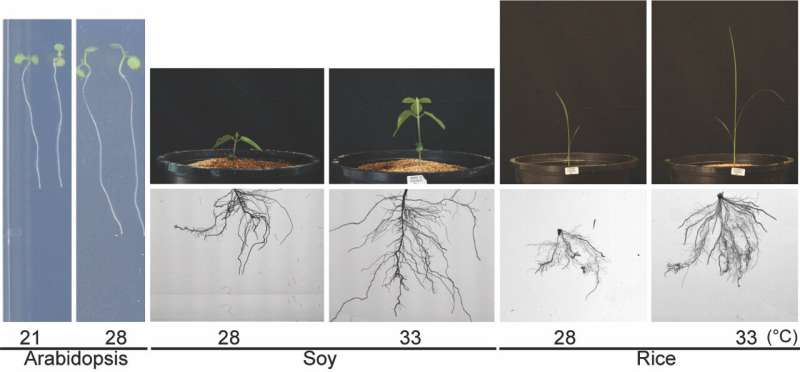This article has been reviewed according to Science X's editorial process and policies. Editors have highlighted the following attributes while ensuring the content's credibility:
fact-checked
peer-reviewed publication
trusted source
proofread
Scientists discover key nutrients that help plants beat the heat

Global temperatures are on the rise, with experts projecting an increase of 2.7°F by 2050. Because plants cannot regulate their own temperatures, they are especially sensitive to these temperature changes.
At higher temperatures, plants instruct their root systems to grow faster, creating long roots that stretch through the soil to absorb more water and nutrients. While this response may help the plants in the short term, new research suggests it's both unsustainable for the plants and potentially harmful for humans in the long term.
Researchers at the Salk Institute have discovered that when certain plants respond to high temperatures with rapid root growth, they are reducing their levels of two important nutrients—nitrogen and phosphorus—which makes them less nutritious when consumed.
At the same time, if the soil contains low amounts of these nutrients, plants return to slower root growth and don't respond adequately to the higher temperatures.
The new molecular details of this interaction between root growth and nutrient availability in the face of high temperatures will inform the engineering of Salk Ideal Plants—a collection of carbon-capturing, climate change-resilient wheat, rice, corn, and other crops created by Salk's Harnessing Plants Initiative.
The findings were published in Nature Communications on June 1, 2024.
"Global warming will lead to significantly increased temperatures on Earth, and plants are inevitably going to respond," says Salk Professor Wolfgang Busch, senior author of the study, executive director of the Harnessing Plants Initiative, and Hess Chair in Plant Science.
"The fact that higher temperatures deplete these important nutrients in plants is a real concern for the future of human and animal diets, and certainly something we want to account for as we work to design more resilient crops."
Plant growth and development change based on environmental temperatures in a process known as thermomorphogenesis. To gain a deeper understanding of this process, Salk researchers looked at Arabidopsis thaliana, a small flowering plant in the mustard family.
In early experiments, they noticed the above-ground part of the plant, called the shoot, grew longer when exposed to high heat. This led the Salk team to wonder how these temperatures affected the plant's roots, and whether crop plants, like rice or soybean, might respond similarly.
To answer these questions, the researchers turned up the heat and watched Arabidopsis, rice, and soybean plants' roots grow. Just as Arabidopsis shoot growth accelerated under high temperatures, its roots, as well as the rice and soybean roots, accelerated their growth. But there was one caveat: the rapid growth relied on abundant access to nitrogen and phosphorus in the soil.
"Nitrogen and phosphorus are crucial for plant growth, development, and reproduction, so they are already in most fertilizers," says Sanghwa Lee, first author of the study and a postdoctoral researcher in Busch's lab.
"Having connected the dots between these nutrients and thermomorphogenesis, we can now work to engineer plants and optimize fertilizers that ensure growth isn't limited by lack of nitrogen and phosphorus in future higher temperatures."
In Arabidopsis, the relationship between faster root growth and nitrogen and phosphorus levels hinged on two proteins: HY5 and NRT1.1. HY5 is a transcription factor, a type of protein that regulates when specific genes will be turned "on" or "off." HY5 oversees the genetic instructions for NRT1.1, a protein that senses nitrogen and is involved in regulating phosphorus levels and the coordination of plant root growth.
At high temperatures, HY5 and NRT1.1 work together to conduct thermomorphogenesis. But as nitrogen and phosphorus levels fall, HY5 begins to suppress the expression of NRT1.1, and root growth slows down.
Both rice and soybean have similar proteins that share a common genetic ancestor with HY5 and NRT1.1. Busch says the rice and soybean versions of HY5 and NRT1.1 will require more investigation, but are likely to affect root growth and nutrient uptake similarly to Arabidopsis' HY5 and NRT1.1.
"It is now clear that nitrogen and phosphorous are key in controlling root growth under the stress of higher temperatures," says Busch. "This is going to be crucial to consider as we work to overcome the challenges that global warming poses on the large-scale production of nutritious food for a growing global population."
In the future, the researchers will more deeply investigate rice, soybean, and other crops to determine if their HY5 and NRT1.1 protein lookalikes react similarly. They will also look at ways to target these proteins and develop crops that can continue growing their roots even when nitrogen and phosphorus are running low.
Other authors include Julia Showalter and Ling Zhang at Salk, as well as Gaëlle Cassin-Ross and Hatem Rouached at Michigan State University.
More information: Sanghwa Lee et al, Nutrient levels control root growth responses to high ambient temperature in plants, Nature Communications (2024). DOI: 10.1038/s41467-024-49180-6
Journal information: Nature Communications
Provided by Salk Institute




















